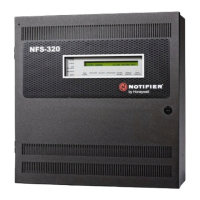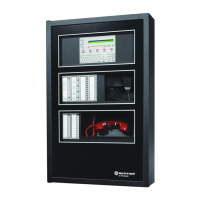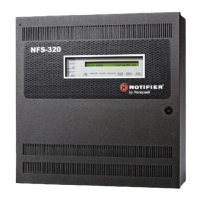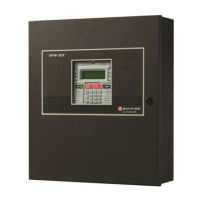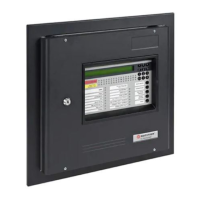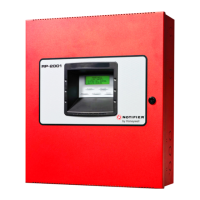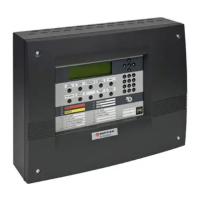NFS2-3030 Listing Document — P/N LS10006-051NF-E:F2 5/19/2022 33
PIEZO: Toggle between OFF and ON. This option enables (ON) or disables (OFF)
the panel piezo from sounding when alarms or troubles occur. A setting of
ON is
overridden if
LOCAL CONTROL is set to NO. Default: NO
PROPRIETARY
SUPERVISING STATION: Press to enable (YES) or disable (NO)
Local Receive mode. When enabled, events and the clearing of events must be han-
dled one at a time: each must be acknowledged. Latching events require a system
reset. The panel will override a setting of
YES if the Node Number is greater than
zero. Default:
NO
EVENT
ORDERING: Toggle between USA and CANADA ordering priorities. This
order is applied to events shown in the Multiple Events List screen. Default:
USA
DISPLAY
ADDRESS: Toggle between YES and NO. Choose YES to display all point
address information at the top of event screens and in printouts. Choose
NO to sup-
press address information display and printing. Default:
YES
REMINDER
MENU: Press to display the Reminder Menu Screen. Refer to
page 34.
MORE: Press to display the second Panel Settings screen.
LCM LOCAL MODE: Toggle between YES and NO. YES to enable all SLCs to
participate in local mode. When enabled, all LCMs will operate together in a
limited fashion when communication is lost with the NFS2-3030 CPU. Inputs
on LCM loops (and associated LEM loops, if installed) will activate outputs on
all loops:
• for those inputs and outputs that have been set with point programming to
participate in local mode, and
• when type codes are the same point type: that is, an input with a fire type
code will activate an output with a fire type code. (Refer to “Point
Programming” on page 43 for point types.)
Default
: NO
POWER
MANAGEMENT MODE: Select ON to invoke the power management mode to conserve power consump-
tion. In this mode, the number of LEDs that can be activated on a particular loop will be limited. A maximum of
30 input device (monitor modules and detectors) LEDs will be allowed on at a time. No output module LEDs
will turn on. When the limit of 30 LEDs is reached, every time a new LED is turned on, the oldest LED activa-
tion will turn off and will poll in red rather than the usual green. Default: OFF
DCC
PARTICIPATION: Press to program the panel for DCC (Display and Control Center) participation. This
network function ensures that one location at a time is in command of the Acknowledge, System Reset, Signal
Silence and Drill (Alarm Signal On for Canadian applications) functions. Default: NO
RAPID
ALL CALL: Set YES to invoke Rapid All Call for XP Series transponder modules. Used when retrofitting an AM-2020/AFP-1010 system
that has XPP modules used for audio operation. This setting causes these modules to activate more quickly. Rapid All Call is used with the “Speaker”
type code. Default: NO
DEFAULT
SETTINGS: Press to activate default settings.
REGIONAL SETTINGS: Press to proceed to the Regional Settings screen.
SCS SETTINGS: Press to proceed to the SCS Settings screen.
NOTE: Proprietary Station does not support standalone mode (direct
connect) with a Digital Voice Command.
NOTE: Fire/MNS priority dependent on fire panel programming. Refer to
Panel Settings on page 32.
NOTE: For fire applications, DCC participation should be enabled for all locations that can participate in
DCC. For mass notification applications, DCC participation should be disabled. When the panel is in
Network Display Mode and used as part of an ACU, LOC, or CCS. the DVC associated with the fire panel
should have Mass Notification Control Settings selected and the node of the fire panel selected. In the
event of a mass notification page, the fire panel associated with the DVC that initiated the page will assume
control of the network until the mass notification page is complete. Each fire panel will assume local control
until a mass notification event occurs.
With Fire as the highest
priority:
With MNS as the highest
priority:
USA Event
Order
Canada Event
Order
USA Event
Order
Canada
Event Order
Fire Fire MN Alarm
MN Alarm Fire Fire
CO Alarm CO Alarm CO Alarm CO Alarm
CO Pre-alarm CO Pre-alarm CO Pre-alarm CO Pre-alarm
Security — Security —
Supervisory Supervisory MN Supervisory
MN Supervisory Supervisory Supervisory
Trouble Trouble MN Trouble
MN Trouble Trouble Trouble
Pre-alarm Pre-alarm Pre-alarm Pre-alarm
Disabled Disabled Disabled Disabled
Panel Settings Screen (2)
PANEL SETTINGS
LCM LOCAL MODE: YES REGIONAL SETTINGS
POWER MANAGEMENT MODE:OFF SCS SETTINGS
DCC PARTICIPATION: NO MORE
RAPID ALL CALL: NO ACCEPT
DEFAULT SETTINGS BACK
Program Setting for: Default:
Local Control YES
Piezo ON
Proprietary Supervising
Station
NO
Event Ordering USA
Display Address YES
LCM Local Mode NO
DCC Participation NO
Power Management OFF
Rapid All Call NO
Default Settings

